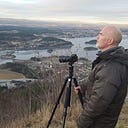A Few Ideas on How to Use a NiSi Vario 1.5–5 Stop Filter
Attaching the NiSi Vario filter to a lens basically means that we have added a fourth dimension to our camera. The exposure triangle; aperture, iso, shutter speed, has been expanded with a fourth variable with which we can play to achieve a desired effect or outcome. This of course opens up for new creative opportunities in our photography, and also adds a lot of flexibility to our shooting.
Let us assume I would like a 30 sec sunrise exposure where my main goal is to smooth the water. My initial camera settings are f11 and iso 100. I set my camera to Live View with the histogram enabled and adjust the transparency of the filter until I am around 30 secs. It may of course be necessary to fine tune aperture and iso settings to perfectly achieve the exposure I am after — including having a decent histogram. As it becomes increasingly brighter I simply adjust the filter, that is, darken it to maintain my 30 sec limit.
Sunrises this far north come in at least three stages where the first warm colors appear when it still is pretty dark and a 5 stop or 6 stop filter are way too dark, whereas 1.5 stops may be just perfect.
(By adding a Dark Reader extension to your browser it is possible to view the images on a dark background)
Personally I find smoothed water of waterfalls and rivers aesthetic and pleasing to the eye. However, there are instances when smoothing a waterfall may have a converse effect — some of its sheer power and wildness are lost. Assume I would like to preserve these qualities of a waterfall, but smooth the water in the ensuing river. With a NiSi Vario filter attached to the lens this double effect can be obtained with a minimum of effort. The two resulting images can easily be blended in for instance Photoshop.
The two exposures blended and given a quick edit in Photoshop:
In this instance I think I would have preferred to use the 1/5 exposure for all the water, but opted to make a blend for the sake of example.
Very often there is movement in the foliage around a waterfall caused by the falling water which set air in motion. This necessitates a fast exposure for the foliage to freeze the leaves. Setting the filter to it max value for the water and next to its lowest value may be enough to produce the desired effect. If I still have movement in the foliage because the shutter speed isn’t fast enough I also adjust the iso and the aperture to achieve a faster shutter speed.
Freezing the foliage:
Smoothing the water:
The finished image:
In this case I also had an exposure for the sun as it found an opening in the foliage which is blended into the image.
Long exposures of water create some very nice and pleasing lines, but textures and details in the water we would like to preserve are sacrificed. Again, using the NiSi vario filter we can get the best from two worlds.
Lines:
Textures:
The finished image:
The finished image also includes a focal length blend to give back the mountains their proper scale and majestic presence in the landscape. In addition there is a fourth exposure for sky.
All images are shot at various locations in Norway.
